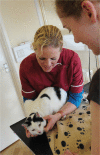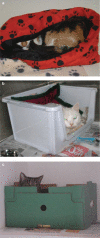AAFP and ISFM feline-friendly nursing care guidelines
- PMID: 22511476
- PMCID: PMC11132257
- DOI: 10.1177/1098612X12445002
AAFP and ISFM feline-friendly nursing care guidelines
Abstract
NURSING CARE: The term nursing care means different things to different people. The authors of these AAFP and ISFM Feline-Friendly Nursing Care Guidelines define nursing care as any interaction between the cat and the veterinary team (veterinarian, technician or nurse, receptionist or other support staff) in the clinic, or between the cat and its owner at home, that promotes wellness or recovery from illness or injury and addresses the patient's physical and emotional wellbeing. Nursing care also helps the sick or convalescing cat engage in activities that it would be unable to perform without help. GUIDELINES RATIONALE: The purpose of the Guidelines is to help all members of the veterinary team understand the basic concepts of nursing care, both in the clinic and at home. This includes methods for keeping the patient warm, comfortable, well nourished, clean and groomed. The Guidelines provide numerous practical tips gleaned from the authors' many years of clinical experience and encourage veterinary team members to look at feline nursing care in ways they previously may not have considered. OVERARCHING GOAL: The primary goal of feline-friendly nursing care is to make the cat feel safe and secure throughout its medical experience.
Figures















References
-
- Carlstead K, Brown JL, Strawn W. Behavioral and physiological correlates of stress in laboratory cats. Appl Anim Behav Sci 1993; 38: 143–158.
-
- Greco DS. The effect of stress on the evaluation of feline patients. In: August J, ed. Consultations in feline internal medicine. Philadelphia: WB Saunders, 1991, p 13.
-
- Paige CF, Gordon SG, Roland RM, Bogg M. Prevalence of heart murmurs and occult heart disease in apparently healthy cats. J Am Vet Med Assoc 2009; 234: 1398–1403. - PubMed
Publication types
MeSH terms
LinkOut - more resources
Full Text Sources
Miscellaneous

